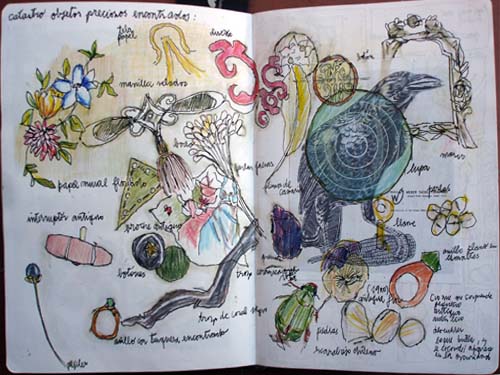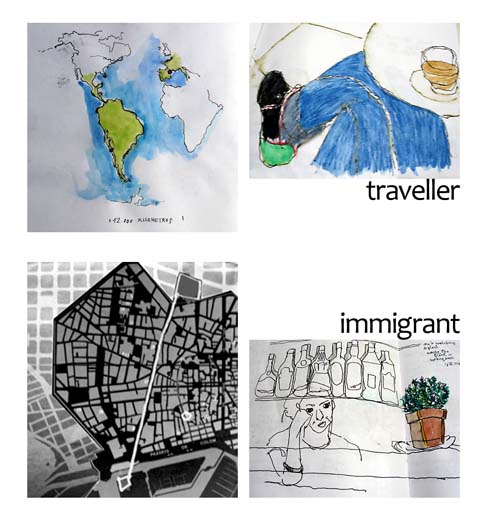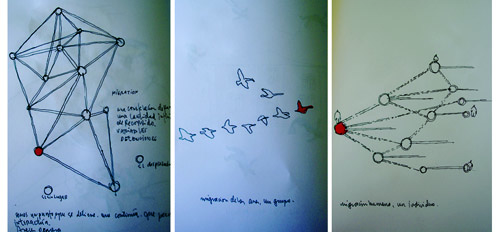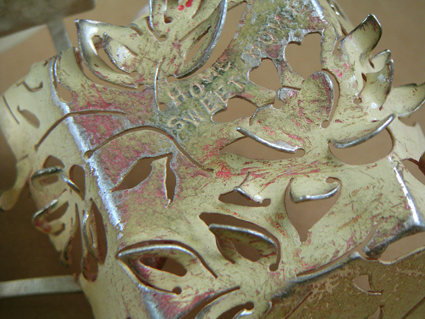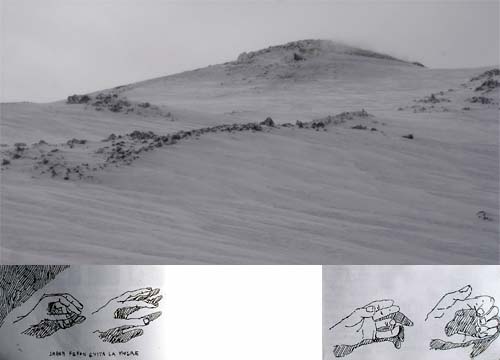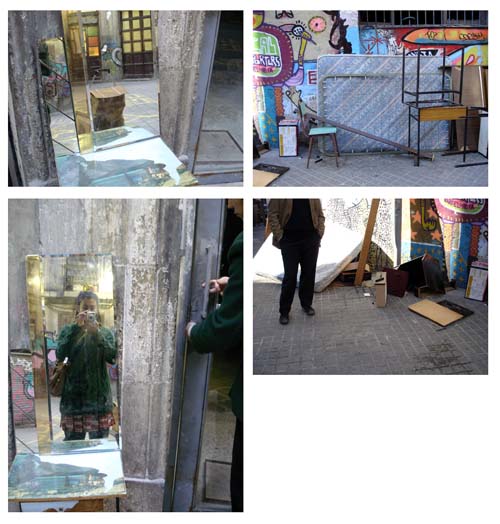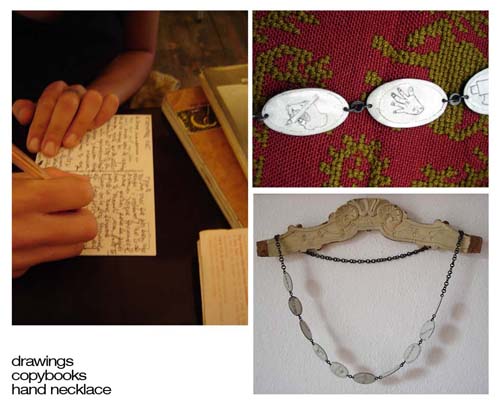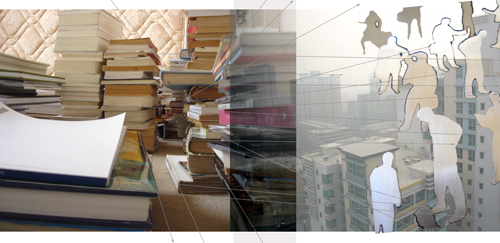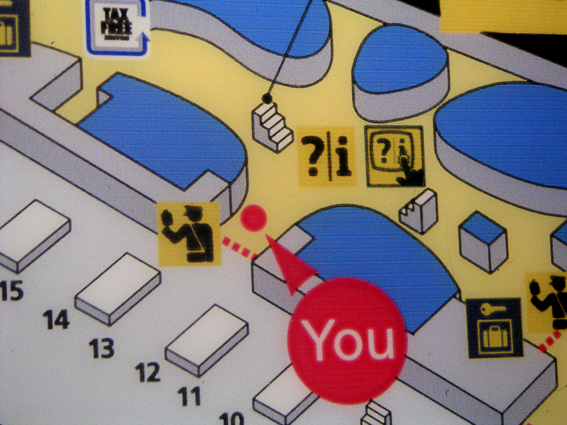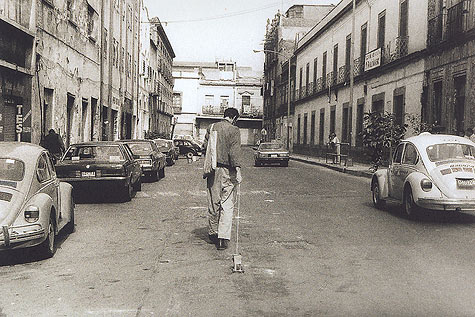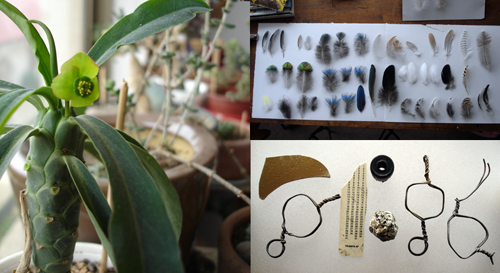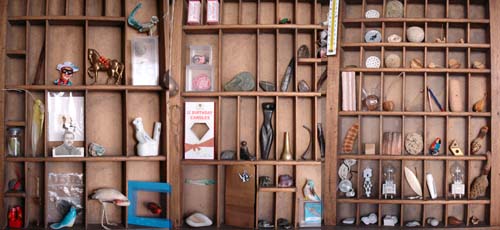Born in Germany (Freiburg in the Black Forest). Emigrated with my parents to Canada (Montreal area) when I was 5. Twelve years later returned to Germany + got a professional economical training. Later discovered contemporary jewelry + its addictive qualities: Berlin for a year technical internship; Hanau (Ger) for a year guest student; then to Amsterdam to study. Now 15 years in Holland, this 3rd culture keeps my very much non-German side in balance with my native German side. I live and work in a studio apartment and love traveling. 
|
|
|
|
Hi Carolina, I hope I get more fluid with this procedure with time since I’m not much of a digital talent – too little patience. This project seemed like tailor fitted for me since the theme of migration – geographical and thus cultural – had started to infiltrate my thoughts for new work quite a while back. I am looking forward to this exchange with you and hearing your migrational thoughts! I’ve posted a picture with my introduction which reflects a bit of my cultural flavor… (the little person is me)
Journey, means “viaje” in spanish. I hope to find in this “viaje”, many doors to unexpected conversations and resources. Shapes and different ways of expression. See you travelling!
Hi Andrea Here’s something about me::: I was born in Viña del Mar, Chile. After I graduated as an architect, I moved to Barcelona, Spain, to continue with my jewellery studies, in the Massana School. I was there for three years. Now I’m linving in the same neighbourhood as always! I love to read, and make drawings. I like birds and travelling. I can play the piano but I prefer listen to others. Many greetings Carolina.- How was your vacation? and where? Warm greetings from Amsterdam
Hi Andrea I was travelling in the south of Chile. And the trip was very nice, with a lot of nice people. I like to think that travelling it’s a constant thought. A thought that start with an image, maybe a photograph or a drawing, and that end with a phrase, at home.- You can see my work in www.joyasdelaodisea.blogspot.com Many greetings Carolina.-
Hi Andrea: I have been thinking about the differences between migration and traveling. Traveling it’s a decision, were you know the times, and the plans. Vacations usually means traveling, or sometimes we travel for our work, or because we just like it. But, what about migration? He estado pensando en las diferencias entre migrar y viajar. Viajar es una decision, generalmente se planea, está pauteada. Se viaja cuando se está de vacaciones, se viaja por trabajo, por gusto. Pero ¿cuándo se migra? Human migration: the permanent change of residence by an individual or group; it excludes such movements as nomadism, migrant labour, commuting, and tourism, all of which are transitory in nature. (E. Britannica) Travel: To go from one place to another. Hi Carolina, You are right about traveling – even when not everything is clear or known, we move within clear possibilities: the distinct time frame of a few days or weeks and also our openness during that time of what we could do and possibly undertake. And really clear is that we don’t have to fit in and make it our home. That effort isn’t at all necessary since we return again at the end to where we came from.
Hi Andrea You can see that I have been very influenced by others in this blog!! This drawing is linked with one of Leonor. H. This shapes suggest me ideas…birds create a group while they are migrating, but for us, migration it’s a personal matter. As individuals. We are alone, in front on new realities, in front of unknow territories. We have to invent ourselves in front of a new human group. Like you said, we have to fit in a new dress, or costume? Puedes ver que estoy muy influenciada por los otros de este blog! Este dibujo está linkeado con uno de Leonor H.- Estas formas me han sugerido ideas…Los pájaros crean un grupo cuando están migrando, pero para nosotros la migración es un asunto personal, actuamos como individuos. Estamos solos frente a nuevas realidades, ante un territorio desconocido, así mismo tenemos que reinventarnos ante un nuevo grupo de personas. Como decías, tenemos que calzar, como quién se hace un nuevo vestido, ¿o disfraz? This is a picture taken during my trip in the summer. It’s inside the Antelope canyon in Utah. What I find interesting is that the amazing scope of colors from bright yellow over orange to deep purple is actually only visible to this extent in a photograph. In reality the eyes don’t see all these extreme hues. My link to the idea of Gray Area is this:
‘Home Sweet Home’ 2007 (Andrea Wagner)
Hi Andrea…. The monochrome of the desert, has taken you into meditations about the gray area, about the distances that we need to see with clarity the environs of our reality. The whiteness of the mountains (monochrome) take us to see what we have closer to us. Ourselves. In a cloudy and white day, this is the most clear and sharp instance we have. This will be our refuge. Home sweet home are us. Maybe our body, or maybe just our mind-memories. C.-
Hi Andrea 1_These days I have been helping my parents to move to a new flat. I have been thinking about my experience in Barcelona. Moving from one flat to another, finding on the way people from all everywhere. Making friends and loosing them. Drawing my journey on the pavement. Keeping all my life into boxes. Scattering my possessions through the city. Traveling? Migrating?
2_Traveling usually isn’t very productive, but very inspiring. I use to travel with my copybooks and watercolors……and then I “translate” those drawings into pieces. As the photograph I include in this post. Of course, the purpose of traveling is being out from our daily routine, and we don’t have our tools with us, but we have cameras, pencils and memories. It’s that so obvious? This blog has become very lively and is definitely collecting and connecting all sorts of very interesting aspects around the themes of migration, home, jewelry! I wanted to share with you something that I discovered reading in the book THE CRAFTSMAN by Richard Sennett about goldsmiths and migration: In the medieval days an apprentice goldsmith was place-bound during his first stage of learning the basic techniques. But after that, once having proved himself by locally presenting his chef d’oeuvre he became a journeyman. This way by moving from city to city and responding to opportunities the traveling goldsmith became a convincing master craftsman who tended to be entrepreneurial with managerial talents, having been made strong by travel and mobility. In fact I wasn’t aware of this aspect before at all and find it extremely interesting how so many contemporary jewelers – and this our group especially, are actually following an age long tradition! I would really like to express an extra special thank you to José Manuel for your input and also to Galeria La REFACCIONARIA for their enthusiastic offer and reception of the project!
mudarse, (in spanish) 1 (de casa) to move (silhouette_silver brooches 2007)
Hi Carolina, at the moment I’m getting last things done before leaving for Germany next week. I am going for a 2 month artist in residency there, but for my money job in Amsterdam I will be going back and forth almost every week. You guessed it! I will be crossing country borders regularly – Migrating! Of course this means being immersed again in a place that links directly to a large part of my heritage even if the geographical area is different. Interesting will be the effect this mentality has on me after I have taken years to move away from it. This is in fact an ideal time to do this while blogging and thinking around a project that actually has to do with migration.
Hi Andrea: Good luck with your two month residency in Germany (where are you going to be?), it will be very nice to hear how it’s to cross the border so often! I’m posting a picture of Francis Alÿs and The collector / El colector. In his actions, he is constantly moving, migrating, using the city as a 3D map. The city is the base to collect objects, or to disperse them (see The Paradox of Praxis ). I ‘m imagining that you can attach a big magnet to you, so each time you cross the border, invisible, minimum, discarded objects get attached to you, as a translator of your experience. © Foto: Francis Alÿs I had to chuckle at the idea of all those things sticking to me, and at the same time it’s terribly SCARY! My nature is being a collector of things I find interesting for their material or appearance or the memories they hold and keep me connected with. But for some time now I’ve been trying more to throw things out faster, delete more, and still incoming things with scarcity of time seem to keep the upper hand… So let’s please make that a selective human magnet – only what does me good or what I can use! Thankfully the EU doesn’t have border controls anymore, so that I won’t have to declare what I have been collecting with my magnet! Are you a ‘collector’, and if so what kind of things? Warmly from a beautiful autumn Amsterdam, Andrea (Here’s one of my new ‘acquisitions’ from the summer which is now decorating my bathroom: a little children’s plastic crab I found in the sand when I went to San Diego’s Silver Strand Beach with my niece)
It’s taken me awhile to get back to you with a response regarding your wondering what the crossings (or connections) are between crafts, art, and design that make jewelry more far-sighted than visual arts and also so detached from design in the traditional sense of the word. I’m going to partly cite you and also supplement it according to how I understood what you meant to convey, as well as adding my thoughts to it. As you said, once Art with a capital ‘A’ came onto the scene those making it – the artists – were driven into (training) institutions to learn what was considered as art and what the ‘proper’ way of creating it was. This in contrast to the first hand-made objects that mainly ‘celebrated’ nature (an inexhaustible laboratory of inspiration) or their religious-mythological beliefs. Design in products that were meant for consumption followed later, pretty much free of conceptual or religious aspects and geared more to the aesthetic. Even later, when the Bauhaus in Germany and De Style in the Netherlands for example set down very clear new parameters regarding design that created a totally new aesthetic and idea about the look of consumption objects. Thus was born ‘Design’ based on clear visual aspects relating to function and functionality. Art which later became more and more conceptual and worked with meaning stood across from it. And on the side stood the crafts which created functional things through more time-consuming hand labor but mostly without the strictness of the clear visual aspects of ‘Design’ (assembly/factory work). Jewelry as embellishment of the body, for a long time meandered along the different styles of the times but not really adhering to any of them properly. I’m not an historian, so what I am saying is without claim to being the truth, on the contrary it’s only a reflection of what I observe and feel. As I see it, things started becoming fascinating once the aspects of design, crafts, and art started intermingling and boundaries blurring. Of course that opened some new cans of worms and the discussions are ongoing still. Such as Art not viewing ‘decorative’ applied arts as equals, or design not searching for association with crafts and so forth. I don’t want to go into that – it’s an endless loop. Personally, I often find wonderful surprises in design or conceptual crafts. Quite often I experience the thinking behind design/conceptual crafts extremely witty, or with interesting references to the traditional in a very contemporary manner, or being critically reactive to society/life, and this often exceeding what I notice in Art. Again, this is just my personal opinion and taste! Students of crafts departments at good art schools are conveyed the necessity of having a good basic knowledge of art history and contemporary art besides being proficient in their own area of expertise. Of how many painting, sculpture, or new media students/artists can the same be said regarding a knowledge of any field of crafts? It is said that knowledge is power, so maybe that helps empower the creative process leading to some very outstanding strong work in the field of crafts. Also, especially jewelry has emancipated itself out of the ‘metals’ corner after contemporary makers do not slavishly adhere to solely using precious materials. Everything is allowed since all the different materials speak their own language and transmit their own visual message. What is being used in Art is today nothing new in Jewelry. And while jewelers use all these different materials they often don’t just use them as such, but research their characteristics, push their boundaries in exceptional ways, and apply them in the knowledge of using that material’s subtle inferred expression or the more expressive outspoken. And on top of that jewelers are kept on their toes by having to additionally incorporate the aspect of function – wearability. To pick up your question again: what makes jewelry look so far ahead of visual arts? I don’t know, maybe jewelers have to try harder, thus ending up by pushing things more, experimenting more with many intriguing results? I hope that somehow answers you! Best, Andrea
Hi Andrea: I really like what you said, you read my mind! Magnets catching indistinctive every kind of objects, without any intention. But we are very selective, that’s what reveal our personality and needs. You asked me if I’m a ‘collector’, and if so what kind of things I collect? And yes, unfortunately, but a “disperse” collector. I use to gather more than collect.I love small objects, old ones, discarded, rusty, forgotten ones. I have a lot of boxes with feathers, bones, hair, buttons, old pictures, eggs, insects, broken porcelain, plastic objects,( I think that’s what most of all, as jewelers do). ….maybe my set of succulents and cactus is my only formal collection. I have been writing 19 copybooks in this last 6 years with drawings and notes…..but, something that I construct can be a collection? Can I collect my thoughts in copybooks? The activity of collecting includes seeking, locating, acquiring, organizing, cataloging, displaying, storing, and maintaining whatever items are of interest to the individual collector. An alternative to collecting physical objects is collecting experiences of some kind, through observation or photography. Agregar, reunir, acumular, acopiar, recolectar, recoger |
|
|
Copyright © 2025 Otro Diseño | RSS |
|

